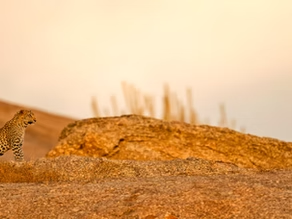JAWAI- THE HIDDEN LAND OF LEOPARDS…….

THE LAND OF LEOPARDS “Rajasthan is a homeland of many legendary figures more than just folk dances and decorated Havelis.“ The state of Rajasthan has always been a home to warriors and kings, home to culture and traditions, but did you know that it also houses the Indian Leopards, one of the most majestic and intimidating animals. These mysterious felines grace the hidden hills of Jawai and disappear into their folds and merge with the lush grasslands, which meet the granite stones on the banks of Jawai River. Jawai is a small village at Abu road tehsil of Sirohi district, located on the banks of the Jawai River, which is known for Jawai Bandh, a famous dam built by Maharaja Umaid Singh of Jodhpur. The place is away from the hustle-bustle of the city and offers amazing views of nature. HISTORY OF JAWAI Jawai holds a significant spot in our history, which is dated back to prehistoric times. A sage named Maharshi Javali, took a shelter here for meditation during the Vedic age. This village is also one of the make-shift shelters of the Pandavas, during their exile period. Today, the village is home to the Rabari tribe, which is believed to have been born from Goddess Parvati, these tribes hence worship goddess Parvati and follow a matriarchal system, where most decisions are taken by the women. These people share a special relationship with animals and continue living nomadic life. HOW TO REACH JAWAI? HOW TO REACH JAWAI? By Road:- Jawai is well-connected to all the major cities of Rajasthan by roads such as Udaipur, Jaipur, Jodhpur, and Mount Abu. By Rail:- There are three railway stations near Jawai, all of which are connected to major cities such as Mumbai, Delhi, and Ahmedabad. The Mori Bera Station, The Jawai Bandh Station and, The Faalna station. By Air:-The nearest airports to Jawai, are located in Udaipur, Jaipur, and Jodhpur. After which you can take a cab or a bus to travel further. PLACES TO VISIT IN JAWAI THE EVER-SO FRIENDLY JAWAI LEOPARDS LEOPARD (Image Credit:- Adaivorukamuthan on unsplash) The leopards and the people of Jawai share a strong and warm relationship, Jawai, not being a conserved wildlife sanctuary should have been prone to leopard attacks, but over the years there has been no such attack, which happens to be fascinating. The story of Jawai has been a success, with the efforts of the people the leopard number had witnessed a rise, within a few years. Since there were no cases of man-animal conflict, the leopards and human beings lived quite harmoniously. Jawai is blessed with picturesque hills and grasslands, surrounded by water, which qualifies it as a perfect environment for leopards to thrive. The place has the highest density of leopards in India and there are frequent sightings of this majestic feline. THE PICTURESQUE GRANITE HILLS THE GRANITE HILLS The magnificent Jawai hills, also known as the granite hills, are home to animals and humans. Over the years these hills have protected and provided shelter to a wide variety of animals. The Jawai hills are not steep, which makes trekking easier, there are many picturesque locations hidden in these hills, one can easily go ahead and experience the wilderness inside. These hills give you a feeling of solitude and help you relax. A BIRD WATCHER’S PARADISE FLAMINGOS (Image Credit:- Jeet Sandhu on unsplash Jawai interestingly is also home to several native and migratory birds, who find temporary shelter here from October to March. Jawai happens to be the appropriate place for bird watchers and ornithologists to explore and study the traits, gaits, and behaviors of these exotic birds. The birds are dominantly found near the Jawai river. The bird-watching experience in Jawai leaves every spectator spellbound with its charm. The place also happens to be a perfect place for curious photographers who wish to capture these little creatures. There are various species of birds found here which include the Indian Eagle Owl, Indian Robin, Lagger falcon, Shikra, Black-winged Kite, Ruddy Shelduck, Bar-headed Goose, Greater Flamingo, Sarus Crane and, Indian Peafowl. THE CROCS THE CROCS (Image Credit:- Pexels) Crocodiles happen to be another major attraction of Jawai. The presence of water and a variety of birds make this place a heaven for crocodiles. Watching crocodiles in their natural habitat, basking in the sun, and hunting for food, is one of the exciting sights to relish. You can easily spot these creatures near the dam. TRIBAL TRAIL THE RABARI TRIBE Jawai, like many other places of Rajasthan, is home to local tribes, The Rabari Tribe to be specific, who rear cattle and live a life of simplicity. In the modern era, where people are diverted towards the western culture, these people tend to stay attached to the roots of their culture as well as nature. These people are the ones who helped conserve and grow the leopard population here. THE JAWAI BANDH (DAM) THE JAWAI BANDH The dam was built by Maharaja Umaid Singh of Jodhpur, across Jawai River, a tributary of Luni river. The dam is a major source of water for Jodhpur and many areas of the Pali district. This is one of the largest dams in western Rajasthan and has recently become a major attraction for tourists. The Jawai Bandh is also home to the Rabari tribe and a variety of animals. The dam provides a precious and fascinating view of the majestic hills. SPIRITUAL TRAIL Jawai has several spiritual centers, where you can rejuvenate your mind and the soul. The Dev Giri Temple, which is dedicated to Aashapura Mata, the locals believe that this goddess protects them from natural calamities. The temple is a monolith located in between the hills. At first sight, the temple gives you goosebumps and happens to be a mesmerizing sight for people. Many times, leopards can be spotted moving freely around the temple. The Kambeshwar Mahadev Temple, which is located in

